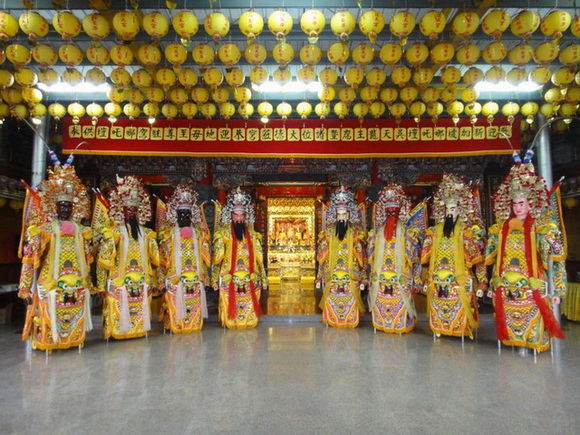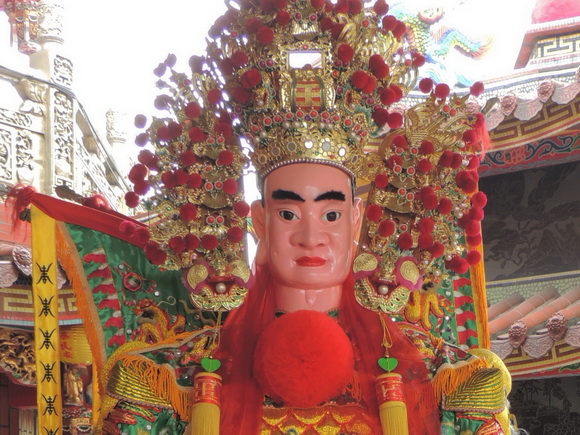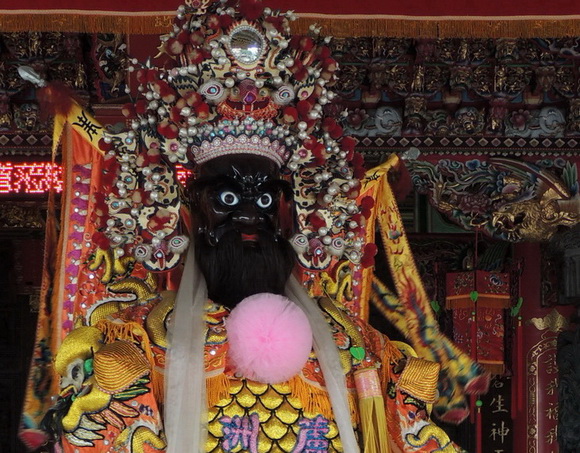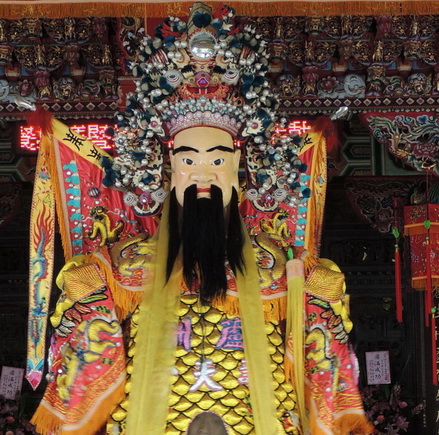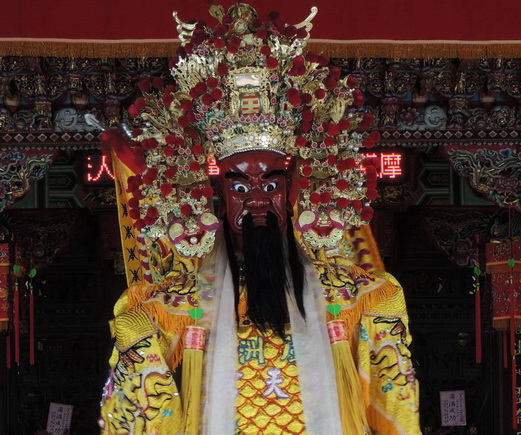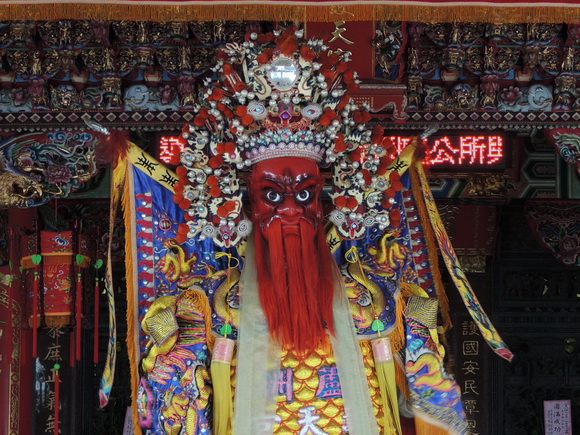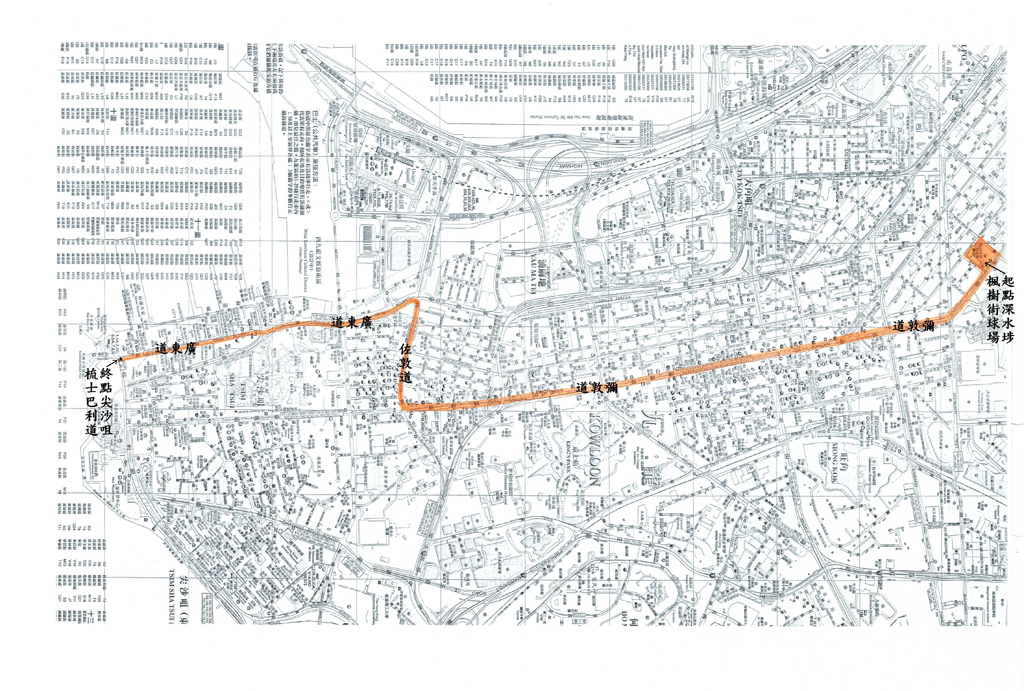作者文章彙整
-
The relation between Taoist culture and it’s beliefs
Seminar atHuachiew Chalermprakiet University
Samut Prakan, ThailandBy Master Leung Tak WahIntroductionI would like to thank the Taoist Hwa Kwong Temple and the Taoist Hwa Kwong Athletic Association 6th Anniversary celebration organising committee and the Huachiew Chalermprakiet University for the opportunity to share at this seminar, but I have to admit I have mixed feelings.Thailand is a predominantly Buddhist country. As a Taoist disciple, I am happy and honoured to be able to share about my beliefs and Taoist culture in an important academic institution like the Huachiew Chalermprakiet University.I am practicing Taoism for over thirty years, and I am ordained as a thirty second generation disciple of the Quanzhen Dragon Gate tradition. I followed my father since young at the Fung Ying Seen Koon, and became the second generation disciple of the temple. I am currently serving as the Tutor of Rites for the Fung Ying Seen Koon. Taoist knowledge is so vast and deep, and I indeed feel nervous and stressed sharing in front of so many university students and academia. I would appreciate if you could highlight and share with me if you disagree with any of my sharing.Taoism is the only indigenous religion of the Chinese, and it encompassed the wisdom of the ethnic Chinese civillisation and its culture and traditions. This year is also the 4710th year of the Taoist calendar.It is really a challenge to share about the Taoist beliefs and culture in an hour, therefore, I will be giving you a brief introduction to two topics. First, I shall share with you the relationship between the Tao (道), Taoist school of thought (道家), and the Taoist religion (道教). Finally, I will also share with you the significance and values depicted in Taoist rituals.(1) Tao, Taoist culture, and Taoist religionThe character “Tao” (道) existed since ancient times, and it signifies the source of the Universe, and the evolution of all creations. This is the origin and source of the Taoist school of thought and the Taoist religion. There are six main schools of thought in ancient China as mentioned in the Records of the Grand Historian (史記) by Sima Qian. Taoism (道家) is one of the six schools, including Confucianism (儒家), Legalism (法家), Mohism (墨家), Logicians (名家), and the School of Yin and Yang (陰陽家). The Five Pecks of Rice tradition (五斗米道) was the first Taoist religious movement established by Zhang Daoling in the late years of the Eastern Han Dynasty, the movement comprised of twenty four dioceses.The Taoist school of thought and the Taoist religion complement one another and they are correlated. The Taoist school of thought is often regarded literally as “philosophical Taoism”, and the Taoist religion is regarded as “Religious Taoism”. The rituals and scriptures practiced in religious Taoism expressed many Taoist ideas and teachings, and these originated from the wisdom of the philosophers of the Taoist school of thought.I would like to cite the following example:The highest deities of the Taoist religion is the Three Pristine Ones, also known as “San Qing Dao-zu” (三清道祖).Presiding in the centre of the “San Qing” is the Primeval Lord of Heaven, or “Yuan-shi Tian-zun” (元始天尊), who held a round pearl in his hands, signifying the “Qi” (炁), or the Original vital breath of the Dao, which is the fundamental energy which existed even before the creation of Heavens and Earth. That is the known as the state of “Wu-ji” (無極).To the left of the “Yuan-shi Tian-zun” is “Ling-bao Tian-zun” (靈寶天尊), also known as the Heavely Lord of the Numinous Treasure. He held the Yin-yang mirror, which signifies the birth of the state of “Tai-ji” (太極) from “Wu-ji”. On the right of “Yuan-shi Tian-zun” is “Dao-de Tian-zun” (道德天尊), or the Heavenly Lord of Dao and its Virtue, also known as “Tai-shang Lao-jun” (太上老君). He holds a fan, symbolizing “liang-yi” (兩儀), or the two energies which symbolized Heavens and Earth.The image of the Three Pristine Ones, or “San Qin Dao-zu”, reflects the Taoist belief of “From one vital breath forms San Qing, the state of ‘Wu-ji’ evolved into “Tai-ji”, and from “Tai-ji” it developed into “liang-yi”, and from “liang-yi” froms all creations and things in the Universe. (一炁化三清,無極生太極,太極生兩儀,兩儀生萬物。) This also reflects the Taoist idea that “Dao” (道) embodies the Three Realms (三界) of Heavens (天), Earth (地), and Man (人), and “Dao” is the source and origin of all creations and objects.The Scripture of Peace and Tranquility (清靜經), Tai-shang Lao-jun (太上老君) expressed that “The Great Dao has no form, yet it forms Heaven and Earth; The Great Dao is unbiased, it governs the changes in the universe and the patterns of the sun and the moon; The Great Dao seeks no acknowledgment, yet it nurtures and provide for all creations; I don’t know the name of this numinous energy, but I named it “Dao” to make reference to it.” (大道無形,生育天地;大道無情,運行日月;大道無名,長養萬物;吾不知其名,強名約『道』。)The Taoist school of thought “Dao-ji”, or philosophical Taoism, regards the “Dao-de Jing” (道德經) by Lao-zi (老子), “Nan-hua Jing” (南華經) by Zhuang-zi (莊子), “Yin-fu Jing” by the Yellow Emperor (黃帝), and other philosophical classics as the sacred texts. These scriptures are fundamental for Taoists to cultivate themselves to assist others (修己度人). Taoists believe that “Tai-shang Lao-jun” came to the mortal world as “Lao-zi”, Zhuang-zi is styled “Perfect Man Nan-hua” (南華真人), and the Yellow Emperor is regarded as the ancestor of the Chinese people, and the ancestral patriarch of philosophical Taoism.Taoist religious beliefs of the immortals correlates to the philosophical teachings of Lao-zi. The Dao-de Jing mentions “The creation of Heaven and Earth evolves to all other creations in the Universe, and this is the greatness of Dao” (有物混成,先天地生,…強為之名曰大。). It also mentions that “Dao creates One, One creates Two, Two creates Three, and Three generates all creations and things in the Universe” (道生一,一生二,二生三,三生萬物。) Both verses explained that “Dao” is the state of “Wu-ji”, One is the “Tai-ji”, and Two is “liang-yi” (道是無極,一是太極,二是兩儀。), and it is a testament that Taoist philosophy and Taoist religion are both inter-related and both complementing each other.Both Philosophical and Religious Taoism believe that “Dao” is the fundamental belief. Taoists believe in the existence of the Three Realms – Heaven, Earth, and Man (天、地、人); and it includes the belief of the immortals and deities in the Heavenly Realm (天界), Spirits in the Earthly Realm (地界), and Man on the Mortal Realm (人界).How do Taoists view life and death? Taoists believe that birth and death is inevitable in all life forms (有生必有死). The exhibition of birth and death, fortune or misfortune, depends on the good actions and wrong doings of the individual. Taoists believe that one who is kind and compassionate will be blessed with longevity and good health, and those with evil intentions and harm others will be plagued with misfortune (善人得賜福長壽;惡人獲降禍厄困).Taoists believe in the heavenly deities and also the spirits. One who accumulates merits and does good will be able to attain the Dao, ascend the heavenly realms and free from all sufferings. Those who commit bad actions will be condemned to the netherworld and not be able to liberate from sufferings.(2) Taoist Rituals and Taoist PhilosophyTaoist RitualsTaoist Rituals are known as “ke-yi” (科儀), where “ke” (科) refers to the sacred scriptures, and “yi” (儀) refers to the ceremonies and etiquette of the liturgies. There are two main categoties for Taoist rituals, one for blessing the living (祈福), and another for the salvation of the dead from sufferings (度亡). The Taoist deities are also classified into Earlier Heaven Deities (先天神) and Latter Heaven Deities (後天神). Earlier Heavens Deities are formed by the vital breath of Dao, which includes the Three Pristine Ones (三清道祖), the Jade Emperor (昊天玉皇), the Five Venerable Sovereigns (五方五老), the Heavenly Lord of Supreme Oneness and Salvation from Misery (太乙救苦天尊), etcetera. The Latter Heaven Deities were once mortals who practiced and cultivated to attain immortality, people who contributed greatly towards mankind or the country, and were conferred as deities by the Emperors or by the common people. Latter Heaven Deities include Celestial Master Zhang Daoling (張道陵天師), Patriarch Lu Dongbin (呂祖師), the Goddess of Mercy “Guan-yin” (觀音大士), Lord Guan (關帝), etcetera.Taoists believe in the existence of the Three Realms, naturally, they will seek the blessings from the heavenly deities to bestow blessings, ward off misfortune, pray for longevity and good health. The Li-dou ritual (禮斗科儀) is one such example to pray for good luck and fortune. Salvation rituals for the dead (度亡科儀) will be conducted to seek the heavenly deities pardon their sins, advocate the proper teachings and counsel the spirits to do good and forgo evil, and also allow the spirits to repent and seek forgiveness for the wrongdoings they had committed, so they may be delivered from the sufferings.Regardless of blessing or salvation rituals, they encompassed different sets of etiquette and protocols,and different type of setups for the altars. For example in blessing rituals, the altar will be decorated in red colour, including the ceremonial robes of the priests which will also be red in colour. As for rituals for the dead, plain colour such as white or yellow will be used in the set up of the ritual altar and the priests will also be dressed in robes which are white or yellow in colours. Most importantly, all the scriptures and text used in the rituals include praising of the deities and immortals, reminders to do good and stay away from evil, repent and turn over a new leaf, and to express gratitude and repay kindness. It guides all to do good and serve others.Taoist PhilosophyTaoist scriptures such as the “Dao-de Jing” (道德經) and “Yin-fu Jing” (陰符經) expressed the ideas of the regulations and laws of nature and the universe (自然定律), relationship and interactions between the five elements (五行變化為哲理), and taught man to learn from history. Teachings such as “wu-wei” (無為) and not striving with others, using gentleness to overcome aggressiveness (以柔克剛), embracement and living together harmoniously (包容共存), the opposing relations between the five elements (五行生克), changes and interactions between the Yin and the Yang (陰陽變化), and other ideologies to advise and inspire the practitioner. It allows mankind to understand and make sense of life and interactions in nature, cultivate oneself, unite the family, and also to govern the country. These ideas influence the beliefs of religious Taoism.SummaryI attempted to introduce the fundamental Taoist beliefs and the relationship between Philosophical Taoism and Religious Taoism in a simple manner, and hope you will pardon me for simplifying any ideas or teachings. I hope that we can have more oppurtunities to share our ideas and research into Taoist culture to achieve a harmonious society, and also world peace.Thank you. -
參與道教日成立暨第13屆香港道教節的巡遊隊伍簡介 (1)
台北蘆洲護天宮地母廟八大神將
神將於城隍祭典時出巡的景況更可見諸於清代的文獻記載,顯示出神將歷史由來已久。台灣的蘆洲神將亦有百年歷史,在台灣各地的迎神賽會活動中,神將以其特有的巨大身形、昂然的姿態,行走於主神神轎之前,一直以來都是迎神賽會裡相當引人注目的陣頭之一。
即將舉行的道教日,香港道教聯合會迎請台北蘆洲護天宮地母廟八大神將參與道教日成立暨第13屆香港道教節的巡遊。這幾位神將早前走遍大江南北,蜚聲海外,深受海外人士認識,如今初來香港亮相,肯定受到矚目。
至於其他八神將分別是:
托塔天王:據《封神演義》,李靖是商朝末年陳塘關的總兵,育有三子,分別是金吒、木吒和哪吒。哪吒三太子鬧海,不慎殺死東海龍王之三子「龍王三太子」,李靖為息事寧人,逼哪吒三太子自殺,後又阻撓哪吒三太子以秘法復活。之後,哪吒三太子在太乙真人幫助之下,以蓮花化身成軀體,並找李靖復仇,李靖不敵,幸遇燃燈道人贈他按三十三天玲瓏寶塔,並將哪吒三太子困於該塔內,父子言歸於好。因此寶塔,李靖被稱為「托塔李天王」。後來,李靖助周武王、姜子牙討伐商紂,立有大功。功成名遂之後,退隱山林潛心修練,終於得道登天,位列仙班。
木吒:在《封神演義》中,木吒是陳塘關總兵托塔天王李靖的二兒子,兄長為金吒,弟為哪吒。木吒是九宮山白鶴洞普賢真人的弟子,曾下山助武王伐紂,擁有道術法寶「吳鉤寶劍」,有雌雄雙劍,下山首功便擊殺九龍島四聖之一的李興霸,後來在遊魂關亦曾斬殺徹地夫人立功。
金吒:曾出現在《西遊記》、《封神演義》等多部文學作品中。傳說金吒是陳塘關總兵托塔天王李靖的長子,有兩個弟弟,分別是木吒和哪吒。在《封神演義》中為文殊廣法天尊弟子,曾下山助武王伐紂。《西遊記》裡,金吒侍奉如來佛祖,做其前部護法。
茍元帥:《警世通言‧金令史美婢酬秀童》稱「原是天上,茍元帥塵緣已滿,眾將請他上天歸班,非擊死也。」也可以解釋為人的去世比如:在【清】洪升的《長生殿·情悔》寫到:「雖謝塵緣,難返仙庭。」
張元帥,字仲疇,河北定興縣人。中統初授御用局總管,改行軍總管。至元元年(1264)進順天路管民總管,次年移守大名,後進益都淄萊路行軍萬戶。以攻宋陷襄陽、下建康有軍功,改亳州萬戶,尋授鎮國上將軍、江東道宣慰使。至元十五年(1278),為蒙古漢軍都元帥攻宋,俘丞相文天祥;次年攻崖山,陸秀夫負宋帝昺蹈海死,宋亡。至元十七年(1280)病死,封淮陽王,諡獻武。
黃飛虎:《封神演義》中的人物,其妻遭到商紂王的調戲並被逼死,黃飛虎率部反叛殷商,逃出朝歌,投奔西歧的周武王。在姜子牙統領的伐紂戰役中,黃飛虎和他的兒子黃天爵、黃天祥、黃天祿、黃天化先後捐軀戰死。有說法黃飛虎的人物原型是姜尚,理由說法黃飛虎是姜子牙的演變脫化,姜子牙在唐朝時被封為「武成王」,與黃飛虎爵位同,而姜子牙號「飛熊」,又稱「飛虎」,應了黃飛虎的名字,所以黃飛虎應該是姜子牙的化身。
劉元帥:宮觀中有「五營座」,擺放於廟內壇桌上之側邊,或放於配祀神神龕內之側邊,也有單獨置於廟內主神旁神龕內或案桌上奉祀。劉天君,名后,東晉時人。生於岷江漁渡中,幼時落波心而不死。因貧,送於羅真人為侍讀,因精於五雷掌訣,能招風捉雨,隨叩即應,濟民助國。是年東京大旱,皇帝禱於劉天君祠,果有大雨。時秋大稔。皇帝敕命其為「立化慈濟真君」。玉皇大帝亦命劉天君職掌雷部王府的各種事務。
龐元帥:原名龐喬,字長清。據《三教源流搜神大全》,龐喬家境貧困,世為駕渡之工。但龐喬心行善良,對往來渡客無不平等,救人急難。玉皇大帝聞其至孝至誠,敕為混氣元帥,手執金刀,唯天門之出入是命,以降陰魔,除舊惡,秋毫不爽。
-
歷史上的道教節 (五)
明朝的道教節
明朝開國皇帝朱元璋,雖然出身于貧苦農民家庭,讀書不多,但他在洪武七年(1374)便注有《道德經》。此書收入明代《道藏》,全名是《大明太祖高皇帝御注道德真經》。現存的資料,不能確定他在位期間有沒有將二月十五日定為節慶。
朱元璋有廿六個兒子,第十七個兒子朱權,著有《天皇至道太清玉冊》一書,此書記載二月十五日真元節,是三教宗師太上老君混元道德皇帝誕生日。
此外,明朝四川巡撫徐應秋,著有《玉芝堂談薈》一書,書內亦有記載二月十五日為三教宗師太上道祖誕辰。
在明朝的資料中,並沒有記載二月十五日是否全國放假。但以二月十五日太上道祖誕辰日為節慶,仍可見于明朝的資料中。
-
歷史上的道教節 (六)
清朝的道教節
在清朝的資料中,我們見到很多對前朝太上道祖誕辰日的回顧,但並未提及清朝有沒有將太上道祖誕辰日定為節慶或全國放假。
如清朝李光地在《禦定月令輯要》卷六記載,唐武宗敕二月十五日玄元皇帝降生日為降聖節,休假一日。黃以周在《續資治通鑒長編拾補》卷三十七記載了宋朝重和元年(1118)將老子生辰日定為貞元節。
雖然我們不肯定清朝官方有沒有慶祝太上道祖誕辰,但民間卻一直保留著這一傳統。在《樓觀台道教碑石》一書中,收有《眾善舍齋文序》,內容是記載清朝初年陝西省數個縣都有舉行道祖誕辰慶祝活動:
我興平縣、周至縣、合武功縣、醴泉縣、乾州各裡居住不同眾善……蓋每歲至道祖聖誕之辰,眾善捐資助糧……六十餘年來,如出一轍……會自康熙二十三年起至今。乾隆十三年歲次戊辰二月谷旦立石。
在碑陰(碑的背面)是結緣碑,刻有不同村落各會首人的名字,這些地方包括龍過村、建坊村、富仁坊、辛莊村、安穀坊、周至縣大莊寨、武功縣山馬村、禮泉縣張村及乾州白樂寨。
按這樓觀台碑石的記載,自康熙二十三年(1684)至乾隆十三年(1748),前後共64年,樓觀台都有舉行慶祝活動,並未間斷。此外,這不光是樓觀台自行舉行的活動,而是眾多縣、州的善信,共同“捐資助糧”,且前後經歷六十多年。
從以上資料,並沒有見到清朝政府將二月十五日定為節慶,也沒有舉行慶祝活動。但我們從樓觀台的碑文可以看到,在樓觀台附近的善信,便連續六十多年舉行道祖誕辰日的慶祝活動,經歷康熙、雍正及乾隆三個朝代。
-
歷史上的道教節 (四)
元朝的道教節
到了元朝,我們亦可以看到慶祝太上道祖誕的記錄。
在金元時期,龍門派祖師丘處機因遠赴西域勸成吉思汗減少殺戮而聞名後世。丘處機的弟子李志常便寫了一本書《長春真人西遊記》,記錄丘處機西行的經過。其中在書的上卷便提到在丘處機西行的過程中,眾人在“真元節”當日請丘處機到郭西郊遊,郭西這地方很大,有園林相接百多裡,為中原所沒有。在這環境下,丘處機便作了兩首詩,記錄在真元節期間游郭西的情況,其中一首便是:
二月中分百五期,玄元下降日遲遲。
正當月白風清夜,更好雲收雨霽時。
匝地園林行不盡,照天花木坐觀奇。
未能絕粒成嘉遁,且向無為樂有為。
詩中提到的“玄元”即是太上道祖,因唐朝追封老子為“玄元皇帝”。玄元下降日,即是太上道祖降生日的意思。
此外,在金元時期有一位有名的詩人元好問,他在世時編輯有《中州集》,保存了大量金代文學作品。他的作品《遺山集》卷三十五中便提及,在忻州(在今之山西省內)有天慶觀,由丘處機的弟子王志常重修。每年二月十五日,即真元節時,都有鶴降臨,少則二三隻,多則十多隻,到來便停留三日,然後才離開。當時的忻州人都習以為常,並不覺得奇怪。
有關天慶觀在二月十五日老君誕期間,有鶴降臨一事,在《山西通志》及李光地著的《禦定月令輯要》都有記載。各書對鶴降臨的記載則是“有定期、無定數”。
元朝統治中原不足一百年,對於漢人並不重視,期間雖然有吸收中原文化及重視道教的政策,但並沒見到將二月十五日定為節慶的記載。
-
歷史上的道教節 (三)
宋朝的道教節——真元節/貞元節
從現存宋朝的資料可以看到,道觀每逢二月十五日仍然有慶祝活動。此外,皇帝亦將二月十五日定為節慶。
在南宋時期,約1127年後,錢塘(今浙江杭州)人吳自牧(生卒年不詳)留下的作品《夢粱錄》提到,天慶觀在每年的二月十五日,都設有老君誕會,燃點萬盞燈,為民祈福。宋朝人在二月十五日點燈的傳統,顯然是繼承唐朝人的做法。
其次,在《夷堅志》內亦有提到,每年二月十五日永康青城山(即今之四川青城山),都設有道會,有很多人參與。
以上資料,可以看到在宋朝時,道教宮觀保持著慶祝太上道祖聖誕的習俗。此外,宋朝的皇帝亦將二月十五日太上道祖誕定為節慶。
按《宋史》記載,宋朝開國初期並沒有太多慶節,到了宋真宗後,慶節便增加了。其中增加的節慶,便是將二月十五日定為真元節。
在宋朝時,太上道祖的稱號不再是玄元皇帝。宋真宗時,稱太上道祖為太上老君混元上德皇帝。故根據宋朝的記載,二月十五日是太上混元上德皇帝降聖日。
宋徽宗在重和元年(1118)四月,便將二月十五日太上混元上德皇帝降聖日稱為貞元節。在清朝徐乾學著的《資治通鑒後編》中,更明確記載將二月十五日定為貞元節,是在重和元年夏天,四月己卯日。
在宋朝的資料中,都有提及宋朝將二月十五日定為節慶,但並沒有提及放假多少日。我們現在並不知道宋朝的節慶,包括真元節,全國放假一天還是三天。
此外,《宋史》對二月十五日這個節日的名稱有不同的記載,在卷二一稱為“貞元節”、在卷一百十二則稱為“真元節”。
-
歷史上的道教節 (二)
唐朝的道教節——玄元節/降聖節
唐朝皇室因為與老子同姓李,故尊奉老子為他們的始祖。在唐高宗乾封元年(666)二月己未日,唐高宗在泰山封禪後不久,便到了老君廟,追封太上道祖為“太上玄元皇帝”。自此,太上道祖便被尊稱為“玄元皇帝”。
在開元三年(715),唐玄宗東封岱岳(泰山),回程時到亳州老君廟,親寫《道德經》,用來刻石,並將老君誕辰日定為“玄元節”。最早將老君誕辰日列為節慶,便是此時。有關此事的記載,可見《太上老君年譜要略》。
除了皇帝外,道教徒早已將二月十五日定為太上老君誕辰日。在《太平廣記》卷二百二十四內,便記載了一個故事,說明這一點。
當時一名書生任之良,希望考進士,可惜考不上。到了“關東店”休息。遇到一名道士。道士跟任之良說,現在應是他個人的名譽和地位最稱心如意的時候,為何不再到京城去?任之良說,因為他欠缺資糧,又沒有居住處。及後,這名道士便給予任之良一些錢,並告訴他可以到肅明觀居住。
任之良到京後,便住在肅明觀內。有一天,他看見一名道士在誦經。這名道士告訴任之良,太上老君的誕辰日是在二月十五日。之後,任之良便向朝廷上表,建議在玄元皇帝(即太上道祖)誕辰日點燈。唐玄宗看了任之良的上奏,接納了他的意見。在二月十五日慶祝道祖誕辰日點燈這一儀式,便是這樣定下來的。
由此可見,把二月十五日定為道祖誕辰日,早在唐玄宗以前,已是道教內的做法。至唐玄宗時,已將道祖誕辰日定為“玄元節”。任之良上奏之後,二月十五日舉行點燈的傳統,便經由唐玄宗確認下來。
以上記載,是有關道祖誕辰當日點燈慶祝的背景。將二月十五日道祖誕辰日定為全國假期,則是在天寶五年(746)二月十三日。按《唐會要》卷五十的記載,當時太清宮使、門下侍郎陳希烈上奏,認為老子誕辰日是吉辰,請唐玄宗准許休假一天。唐玄宗批准陳希烈的建議。於是,二月十五日便成了全國性的假期。可見,距今1264年前,老子誕辰日已經是中國人的假期。
到了唐武宗時期,道祖誕辰日便改名為降聖節。唐武宗在開成五年正月(840)登基,二月即頒令將二月十五日玄元皇帝降生日(即道祖誕辰日)改為降聖節,全國休假三天。道祖誕辰日稱為降聖節,便在唐武宗開成年定下來。此外,這次頒令將原來一天的假期,延長至三天。
及後,唐武宗在會昌元年(841),頒令兩京(即西京長安、東京洛陽)及天下諸州府在太上道祖誕辰日設齋醮,並有免費飲宴三日的安排。太上道祖誕的活動,與以往休假一天相比較,變得更多彩多姿。然而,按史書記載,當年的降聖節假期,又改回為一日。此事的記載,可參考《冊府元龜》卷五十四。
《冊府元龜》卷五十四除了記載唐朝的放假安排外,同卷也記載了唐以後的一些放假安排。唐朝滅亡後,中國歷史進入五代十國(又簡稱為五代)。在後唐明宗天成三年(928)正月,中書上奏,參考唐朝的做法,二月十五日為玄元皇帝降聖節,建議休假三天。明宗李嗣源同意,降聖節假期又改回三天。
綜合上述的回顧,唐朝或以前,道教已將二月十五日定為太上道祖誕辰日。在唐玄宗時期,便定出二月十五日點燈、列為全國假期。此外,在唐玄宗時期,太上道祖誕辰日便稱為玄元節,至唐武宗時,道祖誕辰日改為降聖節,並在降聖節當日設齋醮及飲宴等慶祝活動。
-
歷史上的道教節 (一)
歷史上的道教節 (一)
香港道教聯合會主席 梁德華
文章原載於《中国道教》 2010年03期
2001年香港舉辦首屆道教節。自此,每年的農曆二月十五日,香港道教界皆舉行公開活動慶祝道祖誕辰。
2010年是香港第十次舉辦道教節,香港道教聯合會早在慶典前一年,便成立第十屆道教節籌委會,道末有幸成為籌委會的主任委員,專責處理道教節十周年的慶祝活動。籌委會的其中一項工作,便是研究歷史上太上老君誕辰日的由來及發展。在研究過程中,道末得知將農曆二月十五日太上道祖誕辰日列為慶節,早在一千多年前的唐朝已經存在,並且列為全國假期,放假一天,最多更是放假三天。到了宋、元、明、清各朝,都有慶祝太上道祖誕辰日的記載,本文便是這次研究的一些成果。
-
道教日成立暨第十三屆道教節
道教日成立暨第十三屆道教節
-
日期: 2013年3月10日 (星期日)
-
時間:中午12時 至 下午2時
-
地點:九龍深水埗楓樹街球場
道教日主旨
作為中國土生土長的唯一宗教。香港大部分市民的生活文化與道教文化息息相關。香港道教聯合會經多年來不斷努力與香港政府磋商、申請。結果得政府肯首從2013年起以每年的三月的第二個星期日為「道教日」。香港道教聯合會以此一天來慶祝道教始祖太上老君老子的嶽降,並藉此凝聚信眾,傳達道教與社會、文化及生活的千絲萬縷的關係。
當天活動從中午12時開始有一小時的有開幕典,隨後下午一時開始巡遊。巡遊隊伍由13頭金獅帶領由深水埗楓樹街球場出發沿彌敦道向南行至佐敦道右轉出廣東道向南行往尖沙咀梳士巴利道香港文化中心為終點。
巡遊隊陣容龐大,參加的國家及地區包括有中國、馬來西亞、新加坡、台灣、澳門及香港等六個地區。包括14台神仙地飄彰顯出不同地域的神仙信仰和每個有3米高的八大神將由台灣道教圑體及17人的花鼓隊帶領。此外,道教二十八星宿旗、神仙旛旗隊、金句旗隊、太極隊等。壓軸隊伍是由去年入選健力士世界紀錄的300人組成500呎長的世紀祥龍沿途為現場市民大眾表演助慶。
與巡遊同時間,深水埗楓樹街會場內啟建祈福法事為香港祈求社會和諧及繁榮昌盛。在壇經師誦念經讚,市民同時亦可敬獻鮮花果品,共同祈求福庇。另外,3月21日至25日在尖沙咀香港文化廣場舉行「神仙信仰和民間習俗展展覽」。除展示地色外,還有24幅圖文並茂展板按四時八節排序介紹道教信仰和香港民間習俗,顯示宗教與生活的關聯。
香港道教聯合會希望大眾支持及參與各項道教日的活動,屆時到場祈祈求福庇。同時共襄善舉,宣揚道教。
若有垂詢,請與香港道教聯合會聯絡地址:九龍長沙灣青山道156號永基商業大廈8樓
電話:2396 4881傳真:2391 2001
電 郵:admin@hktaoist.org.hk
-
-
道教信仰與道家文化之關連
梁德華道長講辭
二零一三年一月五日 於 泰國華僑崇聖大學(分校)道教講座前言
今天承蒙泰國道教華光寶殿及道教華光龍師體育會成立六周年紀念雙慶籌備委員會林施紅霞主任委員、葉倡吉統籌暨各位委員及華僑崇聖大學的邀請,主持有關道教的學術性講座,道末一方面感到十分高興,另一方面也覺得十分慚愧。
作為一個道教弟子,能夠在海外一個以佛教為重點宗教的國家裏的高等教育學府 ─ 大學主講道教文化,這是本人特別高興的原因。
不過,本人雖是皈依道教三十多年,屬全真道龍門派三十二傳弟子,自少跟隨先父薰陶在經壇裏,是香港蓬瀛仙館的道裔(第二代),也是蓬瀛仙館經懺導師,總覺得,道體弘深,道術多門,而自問資歷尚淺,在各位學者大德面前,班門弄斧,也確實感到慚愧,有說得不對的地方,還請多多指教。
道教,在當前中國流行的宗教中,是唯一的土生土長的宗教,道曆至今是4710年,他有濃厚的民族思想背景,是宗教和文化的綜合體。
今天要在一個小時的講座,講述道教文化並不容易;所以,我只從兩方面簡略介紹。第一是道、道家和道教的關係;第二是道教的科儀與德育概述。
(一) 道、道家和道教的關係
「道」這一詞,起源甚早,代表「天地之本源,萬物之衍化」,這是文化的根源,由此化生為道家、為道教。道家是古時六家(儒家、道家、墨家、法家、名家、陰陽家)之一,見於《史記‧太史公自序》中司馬談之《論六家要旨》;而道教則成教於東漢末期,張道陵創立五斗米道、二十四治區,見《道藏輯要》。
道家和道教是血脈相連,互相照應,道教是宗教,道家是哲理,道教很多儀式和經義,都源自道家的理論支持。
現舉以下例子:
道教供奉最高的神仙為三清道祖,居中的「元始天尊」,手捧寶珠,或右手虛拈,左手虛捧(即左右手上下互相懸空作抱球狀),象徵宇宙未分,陰陽混沌之時的精氣──「炁」,稱為無極;左邊是「靈寶天尊」,手執陰陽鏡,象徵無極生太極(宇宙);右邊是「道德天尊」,即太上老君,手執一扇,象徵兩儀(天地)。
三清道祖的形象,就是道教神仙信仰之體系「一炁化三清,無極生太極,太極生兩儀,兩儀生萬物。」表示「道」是天、地、人三界的本體,一切事物的根源。
太上老君的《清靜經》也說:「大道無形,生育天地;大道無情,運行日月;大道無名,長養萬物;吾不知其名,強名約『道』。」
道家以老子《道德經》、莊子《南華經》和黃帝《陰符經》等哲理經義作為寶典,道教徒奉行修己度人的基礎。相傳太上老君化身老子,莊子號南華真人,軒轅黃帝乃中華民族祖先,道家始祖。
道教神仙信仰與道家聖哲老子的思想互相結連。《道德經》曰:「有物混成,先天地生,…強為之名曰大。」;又曰:「道生一,一生二,二生三,三生萬物。」兩者同說,「道是無極,一是太極,二是兩儀。」所以說道家思想和道教科儀是相輔相成,互相照應。
道家和道教同以「道」為本體,道教的信仰即以三界(天、地、人)為體系,包括(天界)神仙、(地界)鬼魂和(人界)人類,所以有生死之說和變化鬼神之說。
所謂生死之說:一切生命都是有生必有死,生死的變化依賴着善與惡和禍與福的因果報應。善人得賜福長壽;惡人獲降禍厄困。
鬼神之說,積善之人果報得道,位列仙班,永得人身。作孽之人,三魂化體,七魄離床,沉淪六道,不能超昇。
(二)道教科儀和道家哲理概述
道教科儀
「科」指仙經懺本,「儀」指祭祀儀式。科儀共分祈福和度亡兩類別,神明分先天神和後天神。先天神是道炁衍化的神明,如三清道祖、昊天玉皇、五方五老、太乙救苦天尊……後天神是人經過修行得道或對民族國家建大功勳,被皇帝敕封或由人民奉祀,如張道陵天師、呂祖師、觀音大士、關帝等。
道教信仰既是三界為體,自然地,祈福是向神明祈求賜福消災,趨吉避凶,例如禮斗科儀是求健康長壽,除病延齡;拜懺科儀是求解厄避難,保安消困;度亡科儀是幽科,為死去亡靈解除罪孽,勸化歸正,協助亡靈懺悔,得以輪迴超昇,重返人道。
無論是祈福和度亡的科儀,它們都有著不同的拜祭儀式、不同的道場佈局和秩序。例如為生人祈福屬吉祥法事,袍衣和壇飾都是紅色為主。為死者超度屬喪亡法事,袍衣和佈置以素色(黃/白)為主。最重要的是,所有祈福和度亡的仙經懺本,內容都是以讚頌仙真、勸善修德、因果報應、警覺悔改和感恩報本為主。不論對象是生人或亡靈,都是勸化信眾修善,導引他們承負因果。
道家哲理
道家的寶典《道德經》、《陰符經》……等等都以自然定律、五行變化為哲理,教人執古之道以禦今之有,用無為不爭、以柔克剛、包容共存、五行生克、陰陽變化等哲理勸化人性,返樸歸真。這使人明白處世之道,放下個人私慾和執著,用於處事待人,是修身、齊家、治國的學術,與道教的經義相互吻合,同出一轍。
總結
這次講座,道末謹以簡易的方法來介紹道教和道家的基礎,實在貽笑大方,敬希原諒。期望將來持續往來交流,探討道教文化,共揚道義,使社會和諧,世界和平。謝謝。
